As its name suggests, the Garmin Enduro 3 is built with ultimate endurance in mind. That means a tough, rugged build, but also impressive battery life with solar charging.
Indeed, the main USP of the Enduro 3 over other watches in the Garmin range is that it boasts the best battery life in the entire Garmin range and one of the best in ours.Outdoor watches group test.
The stats are impressive. Equipped with solar charging, even with all satellite systems running including multi-band GPS, it will last between 60 and 90 hours (depending on sunlight conditions). Meanwhile, you get 36 days in standard smartwatch mode.
It's loaded with features, boasting as much functionality asGarmin's top-end Fenix 8. This means plenty of data at your fingertips, but also seemingly endless menus and sub-menus to scroll through.
The five-button interface and scrolling touchscreen will be familiar to those who already have a Garmin watch, but otherwise takes a little while to learn. If you like getting granular with your training, health and performance metrics, though, you’ll love what it has to offer. If you prefer things sleek and simple, not so much.
Having said that, the watch display is highly customizable. Navigation is robust, featuring full-color topographic maps, easy route following, and multi-band GNSS support, ensuring accurate tracking even in challenging environments.
It also works well with numerous third-party apps, from Komoot to Strava to Spotify. You can also set up contactless payment if you want smartwatch-style functionality for everyday use.
Disadvantages? Compared to the latest AMOLED watches, the MiP (Memory-in-Pixel) display is underwhelming, though it's still better than LCD screens. And this loss in terms of overall brightness and clarity is part of what ensures such impressive battery life.
For extended off-grid adventures, it's a sacrifice worth making. There's no voice assistant, as with the latest Fenix model, but I didn't miss that feature. It's expensive though.
Design and display
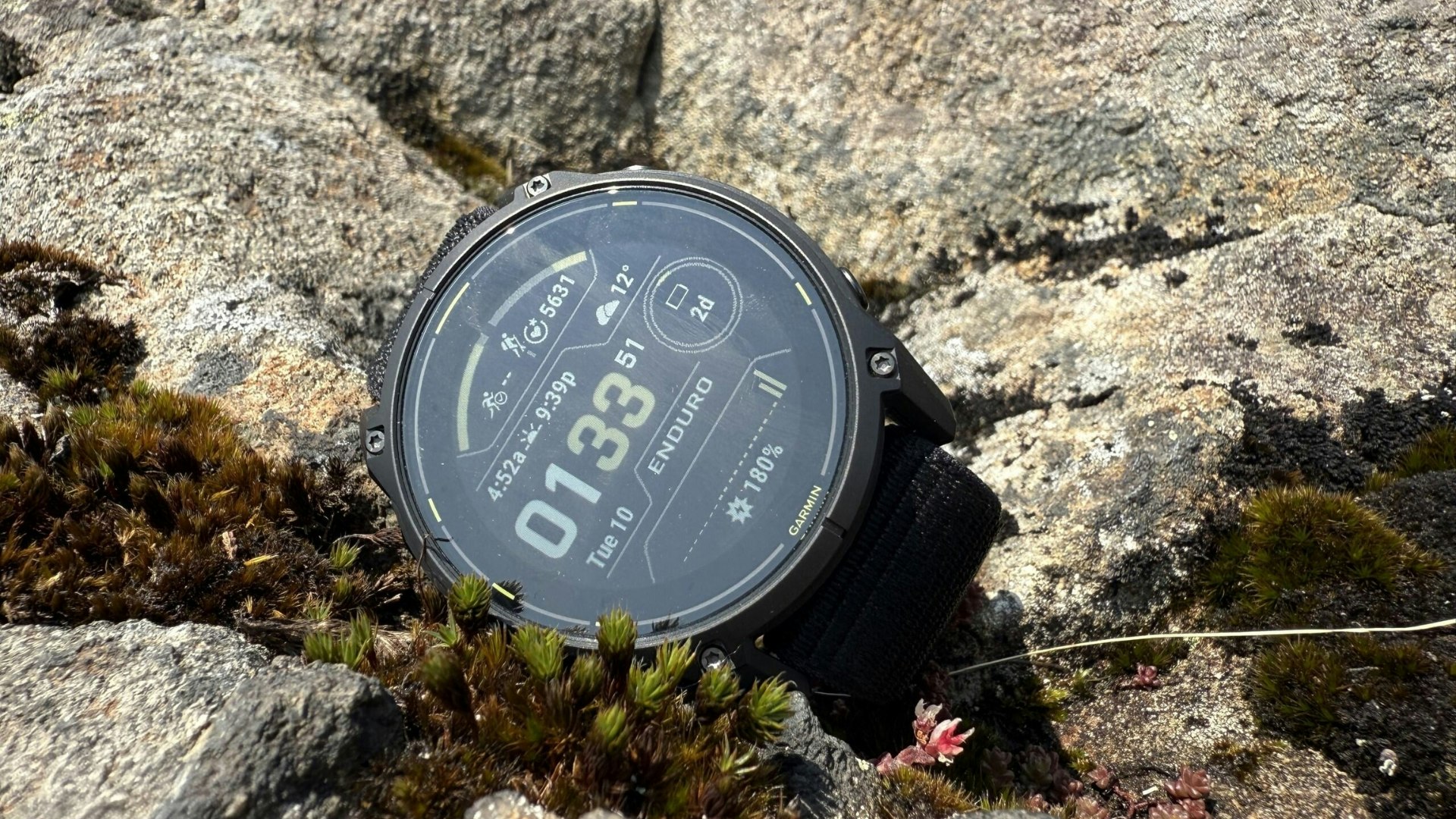
The Enduro 3 is unlike many of the watches in Garmin's other ranges, like theFenixand the Forerunner. Those models come in a bewildering range of different color options and finishes, with multiple strap options (some of which increase the price significantly).
In contrast, the Enduro 3 keeps things simple. It's available in one case size (51mm), one color (no nonsense black) and with just one strap option (a simple but comfortable nylon-velcro band).
The titanium bezel is bolted to a fibre-reinforced polymer case, with a sapphire crystal that is far more scratch-resistant than mineral glass. It's not a particularly heavy watch, at 63g including the band, but it is undeniably chunky.
The case diameter is 51mm and overall thickness is 15.7mm. If you have slim wrists, it may feel bulky and top-heavy, which some will find off-putting.
But the larger proportions allow for a large screen size of 1.4" (35.56 mm) in diameter – and that doesn't include the solar charging ring surrounding the display. In turn, this means you can immediately view plenty of information straight from the home screen (although of course, it's possible to download multiple watch faces, both free and paid, from the Garmin Connect IQ app if you want to customize the watch face).
Visually, the Enduro 3 exudes a rugged and robust quality that will appeal to those who like the G-Shock aesthetic. This is augmented by the addition of an external LED flashlight at 12 o'clock.
It's also a feature on some of Garmin's other watches, such as the Fenix 8,Fenix 7andInstinct 3, and although it seems like a gimmick, it's surprisingly useful – especially if you're wild camping, as it's much more convenient than fumbling around in a dim tent for aheadlamp.
The Enduro 3 has a 280 x 280px 'Memory-in-Pixel' (MiP) display. This is a well-established technology that is widely used across the wearables sector. It's more energy-efficient and thinner than traditional LCD, with low power consumption to boost overall battery life.
It works pretty well outdoors, even in bright sunlight. However, it has a limited color palette and is nowhere near as crisp or vivid as watches with the latest AMOLED displays.
Comfort
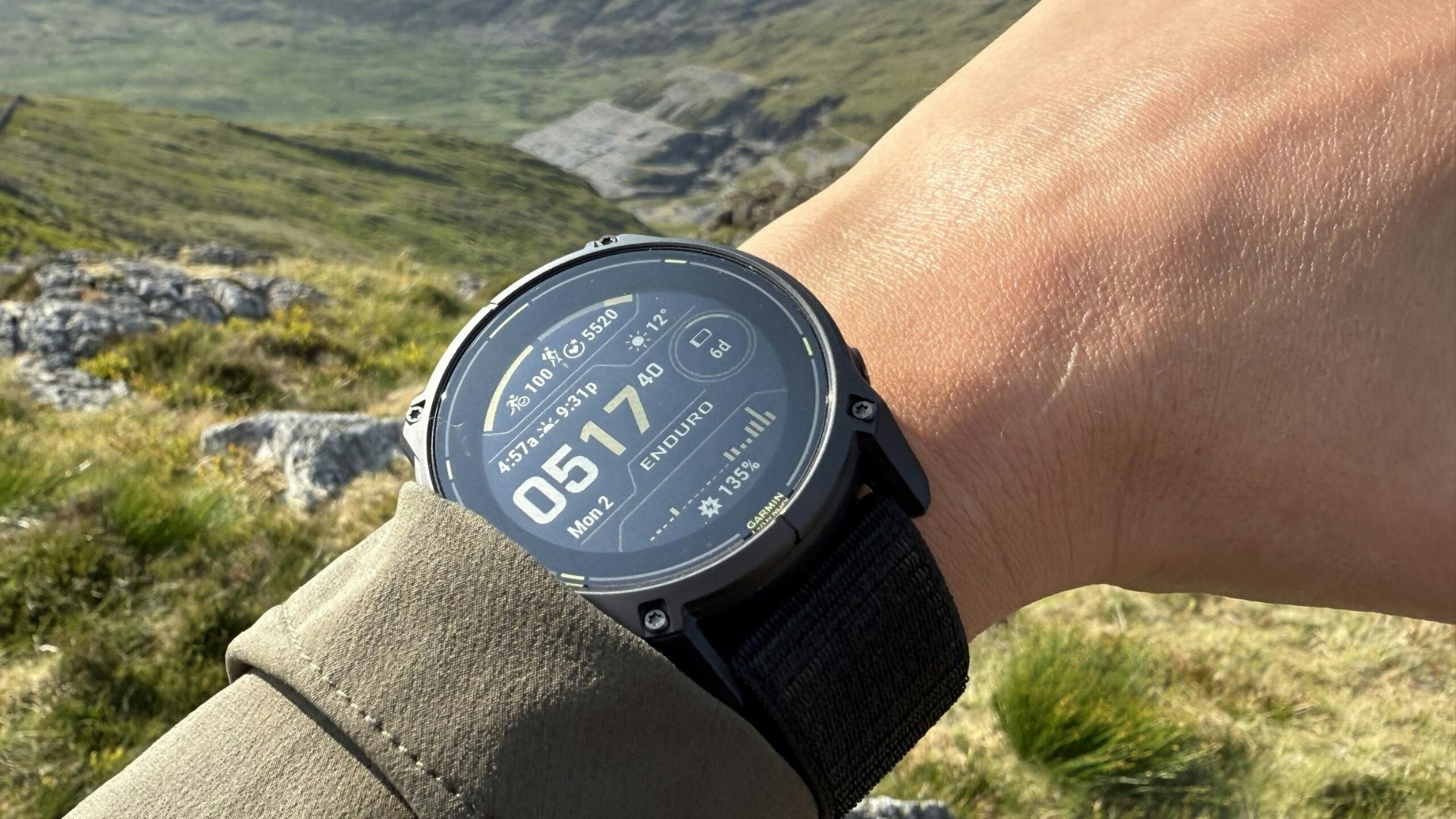
As I've already noted, the Enduro 3 is a big watch, with a diameter of 51mm and a thickness of 15.7mm. On the wrist, it looks and feels a lot like a G-Shock, so if you're used to wearing that type of watch, it probably won't be too bulky.
But others will definitely find it overly bulky, and for fast-paced activities such as trail running – especially if you have a fairly dynamic arm swing – the Enduro 3's extra heft is noticeable, particularly compared to a more streamlined running watch such as the Suunto Race S or the Garmin Forerunner series.
On the other hand, the big case means big buttons and a big screen, which is a plus for overall user-friendliness. And in terms of weight, the Enduro 3 isn't especially heavy thanks to its polymer case and lightweight titanium bezel. By way of comparison, it's lighter than competitors like thePolar Grit X2 Proor theSuunto Vertical Titanium Solar.
The supplied nylon-velcro strap is also soft and comfortable, with infinite adjustment for a great fit. It's also surprisingly quick-drying, as I've found after going for a wild swim in a mountain lake. Overall, I much prefer it to Garmin's silicone straps.
Battery life
The stats for the Enduro 3 are truly impressive. If you're looking for a GPS watch with phenomenal battery life, this is one of the strongest contenders on the market.
In standard smartwatch mode, it will last up to 36 days, which can be boosted to a maximum of 90 days under optimal solar charging conditions (Garmin's figures are based on all-day wear with three hours per day spent outside in 50,000 lux conditions, which would be a sunny summer day here in Britain).
For ultimate battery life, you can put the Enduro 3 in battery saver mode, which restricts functionality and tracking, but then gives you up to 92 days of battery life, or potentially unlimited life if the watch is consistently getting enough solar charging exposure.
Meanwhile, with all satellite systems active and music playing, you can expect up to 22 hours of battery life. Without music but with multi-band GNSS enabled, Garmin claims up to 60 hours of life, or up to 90 hours in optimal solar conditions.
In max battery GPS mode, the brand claims up to 210 hours of battery life, and in expedition GPS mode (which typically records a position update only once an hour), up to 77 days (or again, potentially unlimited days with sufficient solar exposure).
Mapping
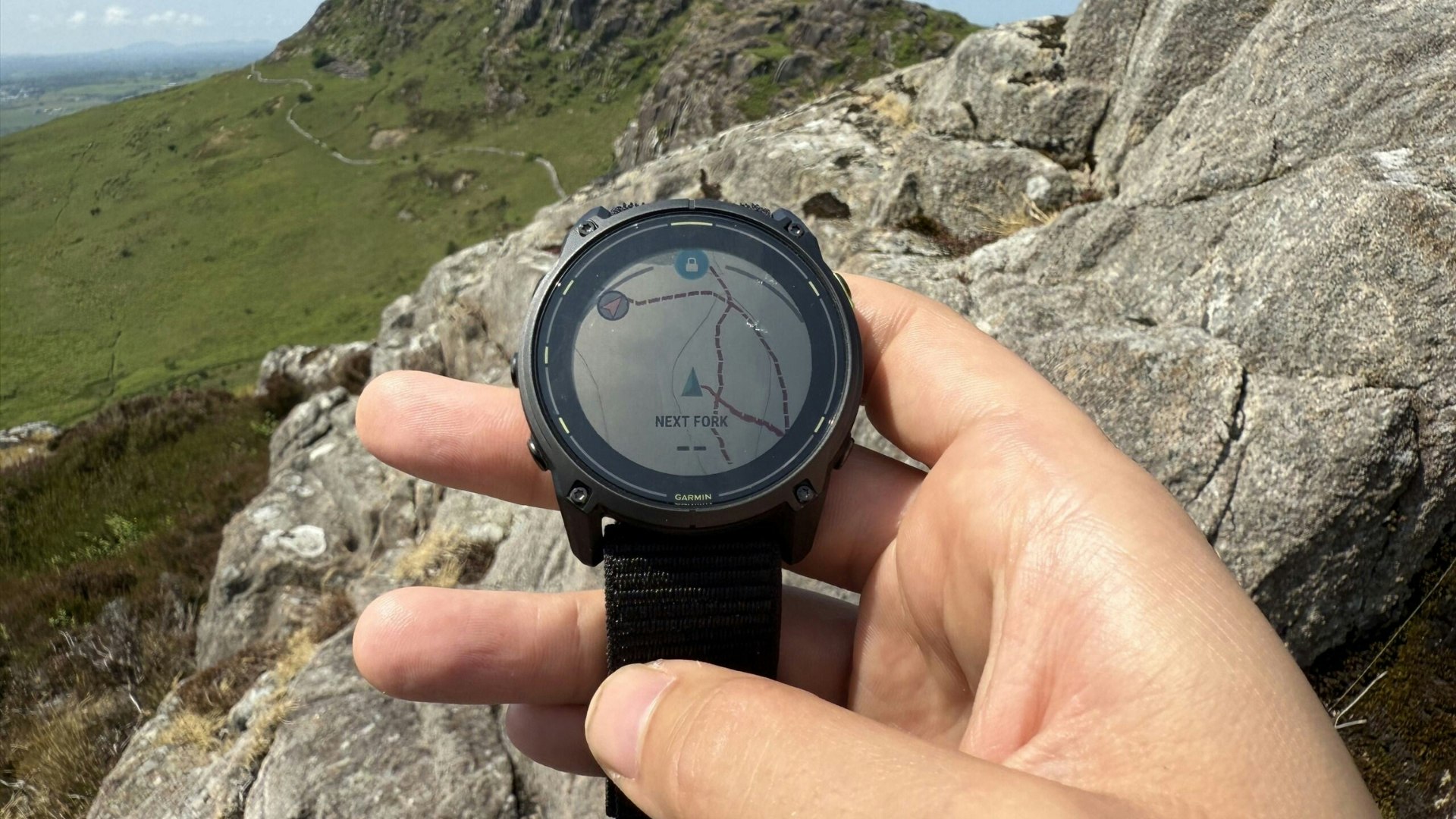
In my opinion, Garmin's mapping is the best free smartwatch mapping on the market. On the Enduro 3, the mapping is pre-loaded. Contour lines and other topographical features are clearly displayed, with landscape features such as villages, rivers and roads labeled.
You can easily zoom in and out via the up/down buttons on the left side of the case, while the touchscreen allows you to pan around the map just like you would if navigating on a smartphone or modern GPS unit.
Of course, navigating on the fly is never easy with a small device like a watch, and most users will import GPX tracks to follow. Garmin's ecosystem is now quite extensive, which means there are several ways you can do this.
If you're a Komoot user, you can do it directly in the Komoot app on the watch, downloadable from the Garmin Connect IQ store. Alternatively, you can import GPX tracks and courses via the Garmin Explore or Connect apps on your smartphone, then sync with your device to upload them to the watch.
You can toggle between map and other data screens, enabling you to monitor hiking or running stats (speed or pace, distance, time, etc.) while following the mapped route. The GPX track shows a lined trace of your progress, as well as the plotted route ahead.
You get turn-by-turn navigation, and if you veer off course the watch will beep and show you how to get back on course. The only downside is that the MiP screen has limited resolution, so on occasion, maps can be a bit dull and difficult to make out.
Accuracy
The Enduro 3 has multi-band capability, connecting to all the major global navigation satellite systems (GNSS): the United States' Global Positioning System (GPS), Russia's Global Navigation Satellite System (GLONASS), China's BeiDou Navigation Satellite System (BDS) and the European Union's Galileo, as well as Japan's QZSS.
In addition, Garmin's own SatIQ technology "dynamically adjusts satellite mode (like multiband GNSS or low-power GPS) based on your environment to optimize battery life without sacrificing accuracy". Basically, it automatically selects the best GPS mode for your situation, whether you're in a dense urban area, a forest, or an open field.
The watch accurately and precisely tracked all my activities, quickly locking onto the GPS signal before starting a hike or trail run. The GPS plots are smooth and continuous.
Interface
The Enduro 3 uses Garmin's standard five-button layout and also has touchscreen capability. If you already own a Garmin watch, the functions will probably feel fairly familiar – if it's all new to you, expect to spend a few hours as you learn your way around the menus.
For example, various short and long presses are needed to access different options and settings, such as the handy widgets menu (long press the top left button). I have to say that, to me, it doesn’t feel as intuitive as some rival brands' interfaces, though that's partly because of the sheer breadth of data and customization that the Enduro 3 offers. Looks-wise it's certainly more dated though.
Fortunately, recording an activity is easy and straightforward, so if you're primarily using this as a multisport watch to log hikes, rides and runs, you can get out and get active pretty quickly.
App
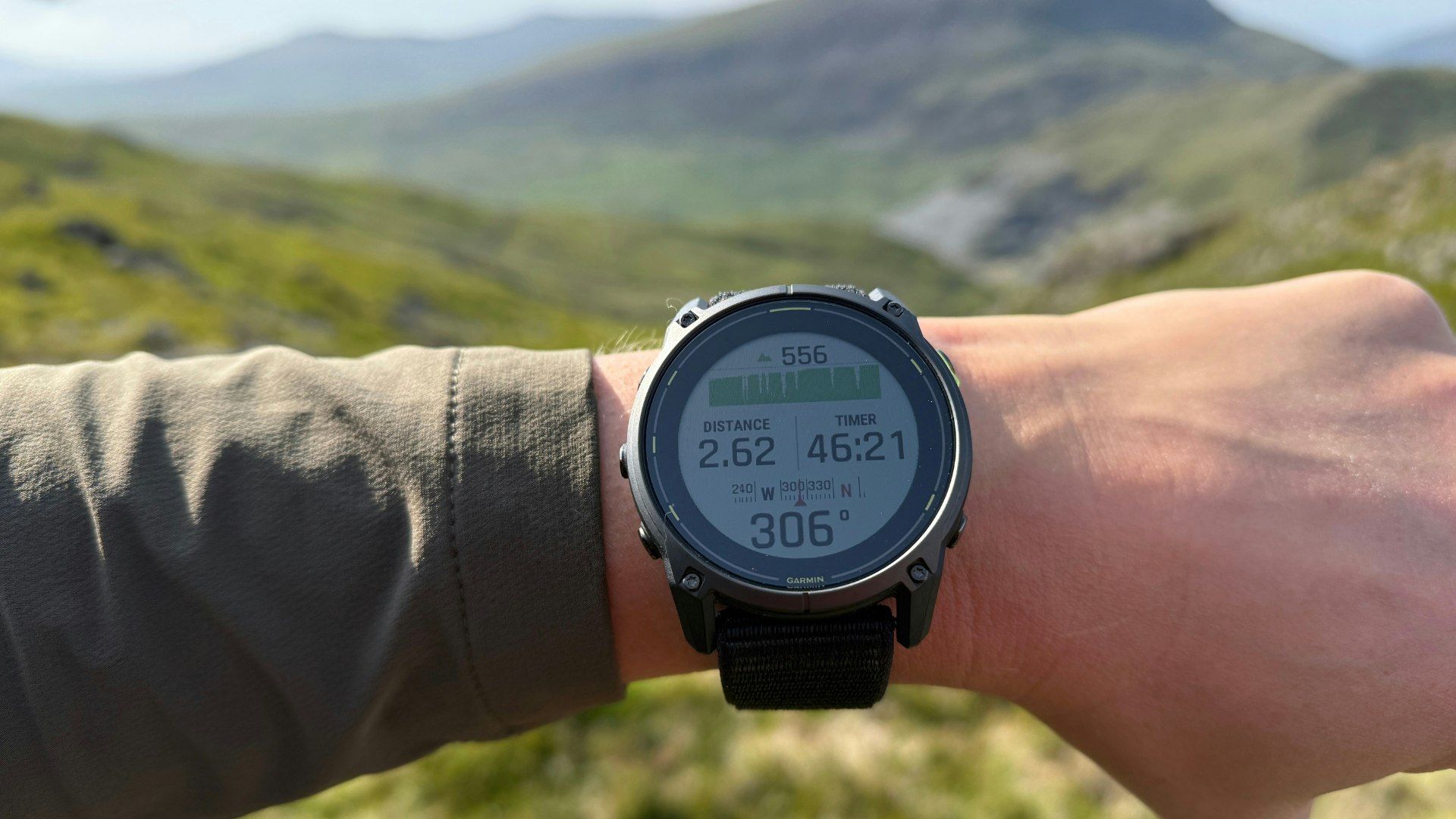
Garmin's ecosystem is extensive, but for us it has also become unnecessarily complex. For one thing, there are now multiple apps available for download to your Apple or Android device.
For outdoor users, the most useful are Garmin Connect, Garmin Explore and Garmin Connect IQ (yes, three separate apps to clog up your phone – sorry). The first is crucial for syncing your watch and monitoring your activities and health/performance stats, as well as setting up training plans.
The second is useful for creating and saving routes, while the third allows you to download third party apps (such as Spotify or Komoot) to your watch, as well as adding custom watch faces (which cost up to £4.99 each).
Garmin recently faced criticism for also introducing Connect+, a paid subscription service that places additional 'premium' features behind a paywall. It is currently £70 per year or £6.99 per month.
Given that the Enduro 3 is a top-tier Garmin watch that retails at £770 in the UK, it's not unreasonable to expect that buying one should really give you access to everything that Garmin offers, without having to pay extra money year-on-year.
What you actually get for this fee varies by device, but essentially the headlines seem to be: personalized, AI-driven insights into your health and activities, a performance dashboard, live activity data fed straight to your smartphone, and Garmin's livetrack functionality (most useful for big challenges, events, and races).
The majority of this will only be of interest to serious/elite athletes, so at the moment I'd advise you to save your money.
Other features
Still, there's a host of other functionality. You can expect excellent sleep tracking (with Garmin's handy morning reports giving you a summary of how you slept and your training readiness for the day ahead), plus heart rate and blood oxygen levels, and multiple health/wellness indicators such as step tracking, floors climbed, intensity minutes, and Garmin's overall stress and 'body battery' metrics.
In terms of outdoor-specific tools, you get dual grid coordinates plus an in-built compass, barometer and altimeter, as well as a thermometer, weather forecast, tide times, storm alerts, and safety tracking (including incident detection, livetrack and live event sharing).
In the mountains, the watch can also give you access to data such as total ascent/descent, vertical speed, route elevation profiles and distance to your destination.
As a multi-sport watch, it's also one of the best on the market. Garmin's running, golfing, cycling and swimming features are some of the most advanced and comprehensive available. So are its training, planning and analysis tools.
In terms of smartwatch-style features, you can also set up contactless payments with Garmin Pay and download Spotify playlists for off-grid listening. I enjoyed heading out for long trail runs without having to take a phone, with the motivating accompaniment of my favorite running playlist (Indie Rock Bangers, since you didn't ask) blasting out throughShokz Openrunheadphones. It works really well (and proved much easier to set up than on the Forerunner 965).
Price and competition
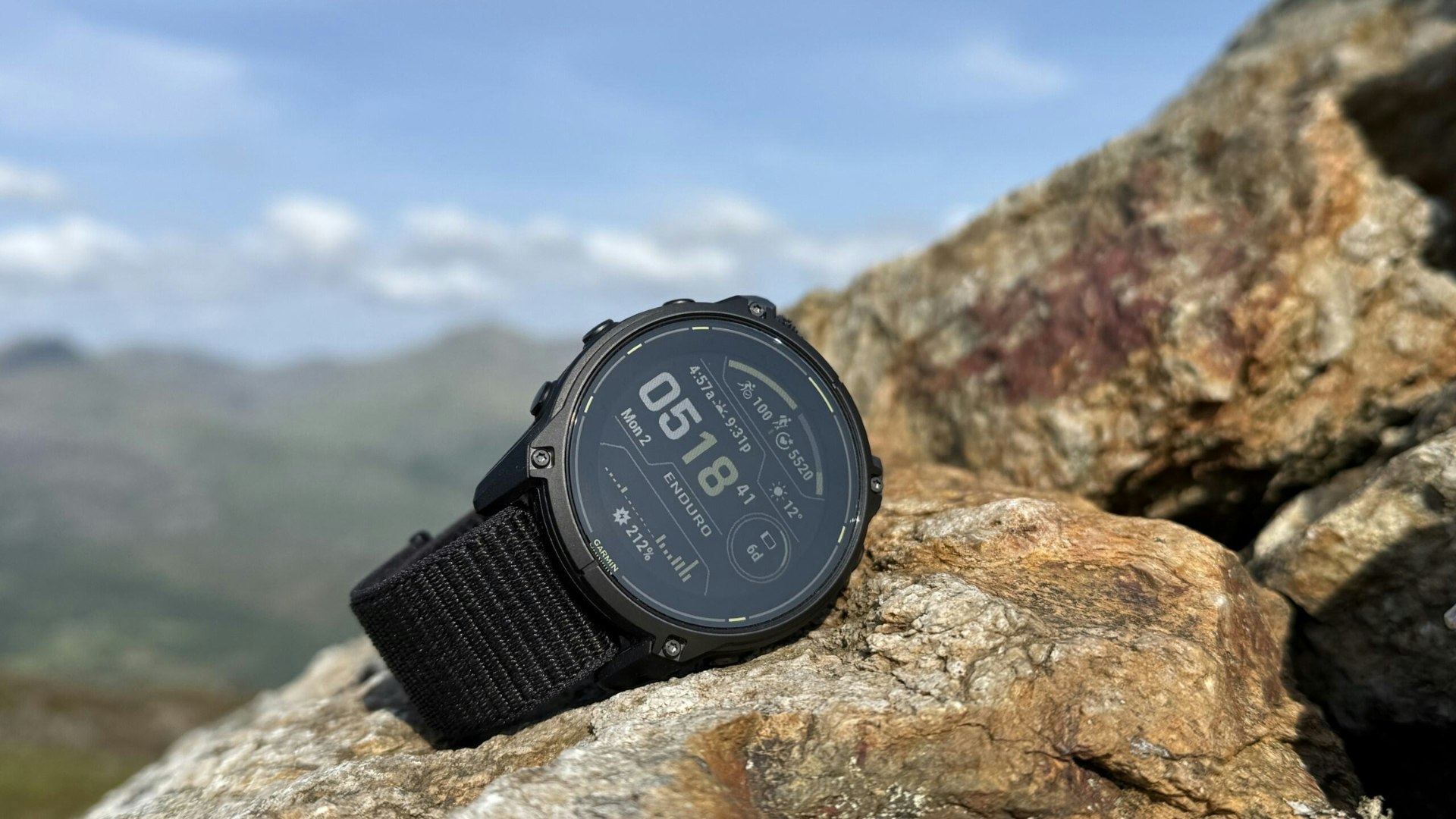
The Enduro 3 is one of the most expensive watches that Garmin offers. Only the premium Marq collection and the specialist dive, aviation, boating and military/tactical models, plus the new Fenix 8 range, are more expensive.
It currently has an RRP of £770 ($899.99), which admittedly saves you a bit of money compared to the 51mm Fenix 8 Solar (£950 ($1,099.99). The Enduro 3 beats it for battery life, but the Fenix 8 has added customisation options, extra smartwatch-style features and a more premium feel overall (though it’s a bit heavier as a result).
Still, the Enduro 3 offers you plenty of features and functionality for your money. In that sense, I think it's better value than the Fenix 8 Solar (if you're considering a Fenix 8, go for the AMOLED version instead).
Away from Garmin, if you like the Enduro 3 you should also be looking at thePolar Grit X2 Pro(£649) and theSuunto Vertical Titanium Solar£625. The Polar has a much shorter battery life and lacks solar charging, but adds a super-vivid AMOLED screen and, for me, offers a more intuitive user experience.
Meanwhile, the Suunto has a long battery life, though still inferior to the Enduro 3, but I think it looks better and may be more user-friendly as it is a little more stripped back.
Verdict
The Garmin Enduro 3 excels in terms of overall durability, battery life and navigation capabilities, as well as multi-sport features and functionality. Solar charging capability also makes this a top choice for users who spend a lot of time off-grid.
The downside? The pixel-based display lacks the color and clarity of AMOLED rivals. And some users find the case too bulky, the display too cluttered and the menus too complicated.
If you're after a slimmer, lighter watch for tracking activities, you may be interested in our list of theBest running watches.
About the author

Matt Jonesis a freelance journalist based in the heart of Snowdonia National Park, he's a highly experienced gear tester and self-confessed outdoor gear geek. Matt has been one of our main gear testers for the last few years and is the first person we call with any complicated kit queries that require in-depth and forensic analysis.
0 comments:
Ikutan Komentar